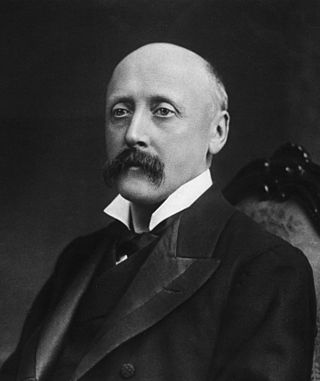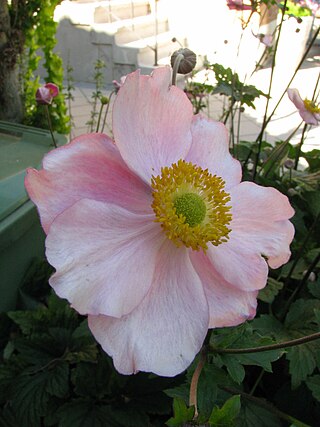
The Royal Horticultural Society (RHS), founded in 1804 as the Horticultural Society of London, is the UK's leading gardening charity.

John Lindley FRS was an English botanist, gardener and orchidologist.

Grevillea, commonly known as spider flowers, is a genus of about 360 species of evergreen flowering plants in the family Proteaceae. Plants in the genus Grevillea are shrubs, rarely trees, with the leaves arranged alternately along the branches, the flowers zygomorphic, arranged in racemes at the ends of branchlets, and the fruit a follicle that splits down one side only, releasing one or two seeds.

Saxifraga is the largest genus in the family Saxifragaceae, containing about 465 species of holarctic perennial plants, known as saxifrages or rockfoils. The Latin word saxifraga means literally "stone-breaker", from Latin saxum + frangere. It is usually thought to indicate a medicinal use for treatment of urinary calculi, rather than breaking rocks apart.

Weigela is a genus of between six and 38 species of deciduous shrubs in the family Caprifoliaceae, growing to 1–5 m (3–15′) tall. All are natives of eastern Asia. The genus is named after the German scientist Christian Ehrenfried Weigel.

William Thomas Stearn was a British botanist. Born in Cambridge in 1911, he was largely self-educated and developed an early interest in books and natural history. His initial work experience was at a Cambridge bookshop, but he also had a position as an assistant in the university botany department. At the age of 29 he married Eldwyth Ruth Alford, who later became his collaborator, and he died in London in 2001.

Sir Isaac Bayley Balfour, KBE, FRS, FRSE was a Scottish botanist. He was Regius Professor of Botany at the University of Glasgow from 1879 to 1885, Sherardian Professor of Botany at the University of Oxford from 1884 to 1888, and Professor of Botany at the University of Edinburgh from 1888 to 1922.
Raymond John Evison OBE, VMH, is a nurseryman, lecturer, author and photographer. Born in 1944 he started his horticultural career at the age of 15 in Shropshire and moved to the island of Guernsey to set up The Guernsey Clematis Nursery in 1984.

Ellen Ann Willmott was an English horticulturist. She was an influential member of the Royal Horticultural Society, and a recipient of the first Victoria Medal of Honour, awarded to British horticulturists living in the UK by the society, in 1897. Willmott was said to have cultivated more than 100,000 species and cultivars of plants and sponsored expeditions to discover new species. Inherited wealth allowed Willmott to buy large gardens in France and Italy to add to the garden at her home, Warley Place in Essex. More than 60 plants have been named after her or her home, Warley Place.
John Dransfield is an honorary research fellow and former head of palm research at the Royal Botanic Gardens, Kew, United Kingdom, as well as being an authority on the phylogenetic classification of palms.

Indigofera heterantha, commonly known as Himalayan indigo, is a species of flowering plant in the legume family Fabaceae. It is native to the northwestern Himalayas of Tibet, in Asia.
Sir Frederick Claude Stern was a botanist and horticulturalist, known for developing the gardens at Highdown Gardens, for creating several cultivars of garden plants and for his publications on peonies, snowdrops and gardening. He also tried to promote the interests of the Jewish community.

Reginald Radcliffe Cory was an influential British horticulturalist.

Eriocapitella × hybrida is a hybrid of flowering plants in the buttercup family Ranunculaceae. The parents of the hybrid are E. japonica and E. vitifolia. Cultivars of the hybrid are commonly known as Japanese anemone hybrids.

Indigofera pendula, the weeping indigo, is a species of flowering plant in the family Fabaceae, native to south-central China. Its cultivar 'Shangri-la' has gained the Royal Horticultural Society's Award of Garden Merit.

Indigofera amblyantha, the Chinese indigo or pink-flowered indigo, is a species of flowering plant in the family Fabaceae, native to central and southern China. A non‑climbing shrub reaching 6 ft (2 m), it blooms from May to September, and is recommended for hedges, borders, massing, and containers.

Indigofera kirilowii is a species of flowering plant in the family Fabaceae, native to eastern, central and northern China, the Korean Peninsula, and Kyushu island of Japan. A deciduous, suckering shrub typically 75 cm (30 in) tall, it is hardy in USDA zones 5 through 7. The unimproved species and a white‑flowered "alba" selection are commercially available.

Indigofera himalayensis, the Himalayan indigo, is a species of flowering plant in the family Fabaceae, native to the western Himalayas. A deciduous shrub reaching 1.5 m (5 ft), its 'Silk Road' cultivar is readily available in commerce.

Indigofera szechuensis is a species of flowering plant in the family Fabaceae, native to Tibet and central China. It is typically found growing on slopes, along trails, and on streambanks at 2,500–3,800 m (8,200–12,500 ft) above sea level. It is a non-climbing shrub reaching 2.5 m (8 ft).

Indigofera candicans, the white-leaved indigo, is a species of flowering plant in the family Fabaceae, native to the Cape Provinces of South Africa. The stems and the undersides of the leaves are white.
















